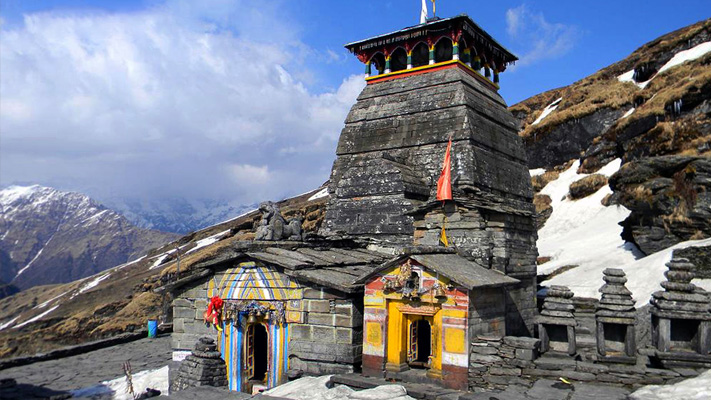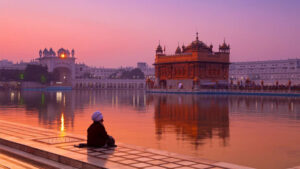10 MAGNIFICENT AND SACRED TEMPLES OF LORD SHIVA – JOURNEY TO THE DIVINE

The worship of Lord Shiva, one of the principal deities in Hinduism, holds immense significance for millions of devotees worldwide. Throughout the Indian subcontinent, numerous temples dedicated to Lord Shiva stand as sacred abodes where devotees seek blessings, solace, and spiritual enlightenment. In this article, we explore ten of the most sacred temples of Lord Shiva, each with its unique legends, architectural splendor, and spiritual ambiance. From the ancient Kedarnath Temple in Uttarakhand to the majestic Meenakshi Temple in Tamil Nadu, these temples have captivated the hearts of devotees for centuries. Embark on a spiritual journey as we delve into the sacredness and profound devotion associated with these ten temples, where the divine presence of Lord Shiva is believed to dwell, and where pilgrims can experience the magnificence and serenity that epitomize the worship of the Lord of Destruction and Transformation.

1. Kedarnath Temple (Uttarakhand)
Kedarnath Temple, situated in the breathtaking Himalayan region of Uttarakhand, India, is one of the most sacred and revered temples dedicated to Lord Shiva. Perched at an altitude of 3,583 meters, amidst stunning snow-capped peaks and pristine natural beauty, Kedarnath Temple holds immense religious significance for Hindus.
Believed to be over a thousand years old, this ancient temple is part of the Char Dham Yatra pilgrimage, which attracts millions of devotees every year. According to Hindu mythology, it is said to be one of the twelve Jyotirlingas, representing the formless manifestation of Lord Shiva.
Visiting Kedarnath Temple involves undertaking a challenging trek through scenic mountain trails, contributing to the sense of devotion and adventure. The temple itself is a marvel of ancient architecture, constructed with heavy stone slabs and adorned with intricate carvings.
2. Amarnath Cave (Jammu and Kashmir)
Located in the stunning region of Jammu and Kashmir, India, the Amarnath Cave is a sacred pilgrimage site dedicated to Lord Shiva. Situated at an elevation of 3,888 meters, this mystical cave holds great significance in Hindu mythology and attracts thousands of devotees each year.
The highlight of the Amarnath Cave is the naturally formed ice stalagmite, which is believed to symbolize Lord Shiva in his formless and eternal state. Devotees embark on a challenging pilgrimage to witness this miraculous ice formation known as the “Holy Lingam.”
The journey to the cave involves a rigorous trek through rugged terrain and icy slopes, often undertaken during the summer months. The chants of “Har Har Mahadev” reverberate through the cave, creating an ethereal ambiance that resonates with the faith and devotion of the pilgrims.
Besides its religious significance, the Amarnath Cave is set amidst breathtaking natural beauty. Surrounded by towering snow-capped mountains and pristine glaciers, the landscape offers a serene and awe-inspiring backdrop for spiritual contemplation.
3. Tungnath Temple (Uttarakhand)
Situated at a breathtaking altitude of 3,680 meters in the Garhwal Himalayas of Uttarakhand, India, Tungnath Temple holds the distinction of being the highest temple dedicated to Lord Shiva in the world. This ancient and revered temple is a significant pilgrimage site for devotees seeking spiritual solace and blessings amidst the serene and majestic Himalayan landscape.
The trek to Tungnath Temple is an exhilarating experience, with a trail that winds through picturesque meadows, dense forests, and panoramic vistas of snow-capped peaks including the magnificent Chopta Valley and the snow-crowned Nanda Devi.
Believed to be over 1,000 years old, Tungnath Temple is part of the Panch Kedar pilgrimage circuit, which includes five sacred shrines dedicated to Lord Shiva. The temple’s architecture showcases intricate wooden carvings and ancient stone craftsmanship, adding to its spiritual aura.

4. Baijnath Temple (Himachal Pradesh)
Nestled in the picturesque Kangra Valley of Himachal Pradesh, India, the Baijnath Temple is an ancient and revered shrine dedicated to Lord Shiva. This architectural masterpiece holds immense historical and religious significance, making it a must-visit destination for devotees and history enthusiasts alike.
Believed to have been built around the 13th century, the Baijnath Temple showcases exquisite craftsmanship and intricate stone carvings. The temple complex is dedicated to Lord Shiva and houses the sacred lingam, a symbolic representation of the deity.
Surrounded by the tranquil beauty of the Dhauladhar Range and the gushing waters of the Beas River, Baijnath Temple offers a serene and divine ambiance for devotees seeking spiritual solace and blessings. The melodious chants and soothing hymns create an atmosphere of tranquility and devotion.
5. Neelkanth Mahadev Temple (Uttarakhand)
Located amidst the picturesque and tranquil landscapes of Uttarakhand, India, the Neelkanth Mahadev Temple stands as a sacred and revered shrine dedicated to Lord Shiva. Situated at an elevation of 1,330 meters, the temple holds deep religious significance and attracts devotees seeking spiritual solace and blessings.
Perched on a hilltop, Neelkanth Mahadev Temple offers breathtaking panoramic views of the surrounding lush green forests, majestic mountains, and the holy Ganga River flowing nearby. The temple’s serene and scenic location adds to its spiritual ambiance, inviting devotees to immerse themselves in the divinity of the surroundings.
Legend has it that this is the very place where Lord Shiva consumed the poison that emerged during the churning of the cosmic ocean, turning his throat blue (hence the name “Neelkanth,” meaning “Blue Throat”). Devotees believe that visiting this temple and seeking the blessings of Lord Shiva here can cleanse their sins.
The journey to Neelkanth Mahadev Temple involves a scenic trek through forested trails and can be a rewarding experience for nature lovers and adventure enthusiasts.
6. Triyuginarayan Temple (Uttarakhand)
Situated in the breathtaking state of Uttarakhand, India, the Triyuginarayan Temple holds immense religious and mythological significance. This ancient temple is believed to be the sacred place where Lord Shiva and Goddess Parvati got married, according to Hindu mythology.
Located in the picturesque village of Triyuginarayan, the temple is surrounded by stunning natural beauty, with the majestic Himalayan peaks forming a dramatic backdrop. The tranquil ambiance and serene surroundings make it an ideal place for devotees seeking spiritual solace and couples seeking marital blessings.
The temple’s architecture showcases intricate stone carvings and traditional design elements, reflecting the rich cultural heritage of the region. The sanctum sanctorum houses the sacred eternal flame, believed to have been burning continuously since the divine marriage of Lord Shiva and Goddess Parvati.
The temple is surrounded by beautiful landscapes, and nearby attractions include the gushing Mandakini River and the stunning views of the snow-capped peaks.

7. Rudranath Temple (Uttarakhand)
Perched in the awe-inspiring Garhwal Himalayas of Uttarakhand, India, the Rudranath Temple holds immense religious significance for devotees of Lord Shiva. Situated amidst lush green meadows and dense forests, this sacred temple is part of the Panch Kedar pilgrimage, which encompasses five revered shrines dedicated to Lord Shiva.
Reaching the Rudranath Temple requires a challenging trek through breathtaking mountain trails, offering panoramic views of the surrounding peaks and valleys. The journey itself is an adventure, immersing trekkers in the natural splendor of the Himalayas.
Surrounded by tranquil meadows, alpine flowers, and the soothing sound of mountain streams, Rudranath Temple offers a serene and spiritual atmosphere for meditation, introspection, and connecting with nature. The temple’s remote location and unspoiled surroundings make it a haven for nature lovers and those seeking solace in the lap of the Himalayas.
8. Koteshwar Mahadev Temple (Uttarakhand)
Located at the confluence of the Alaknanda and Mandakini rivers in the scenic state of Uttarakhand, India, the Koteshwar Mahadev Temple is a revered shrine dedicated to Lord Shiva. Surrounded by stunning natural beauty, this ancient temple holds immense religious significance and attracts devotees seeking spiritual solace and blessings.
The temple is named after the term “Koteshwar,” which refers to Lord Shiva as the ultimate ruler of the universe. It is believed that Lord Shiva himself resides in this sacred place, making it a revered pilgrimage site for devotees.
One of the unique features of the Koteshwar Mahadev Temple is the natural cave behind the sanctum sanctorum. Devotees can enter the cave to witness the naturally formed Shiva lingam, a symbolic representation of Lord Shiva, further adding to the spiritual aura of the place.
9. Mahakaleshwar Temple (Madhya Pradesh)
Situated in the ancient city of Ujjain, Madhya Pradesh, India, the Mahakaleshwar Temple is a revered and ancient shrine dedicated to Lord Shiva. As one of the 12 Jyotirlingas (manifestations of Lord Shiva) in India, this temple holds immense religious significance for devotees and is a significant pilgrimage site.
The presiding deity of the temple is Lord Shiva in the form of Mahakaleshwar, representing the ultimate cosmic power. Devotees visit the temple to seek blessings, offer prayers, and witness the sacred Jyotirlinga, an iconic representation of Lord Shiva’s divine presence.
The Mahakaleshwar Temple is renowned for its unique rituals, including the “Bhasma Aarti” (ash ceremony) that takes place early in the morning. Devotees gather to witness this sacred ritual, where ash (bhasma) is applied to the lingam, accompanied by devotional chants and hymns.
The city of Ujjain itself holds immense historical and cultural significance, being associated with ancient Indian civilization and mythology. Apart from the temple, visitors can explore other attractions in Ujjain, including the sacred Kshipra River, the Kal Bhairav Temple, and the observatory of Jantar Mantar.

10. Kashi Viswanath (Varanasi)
Kashi Vishwanath Temple, situated in the ancient city of Varanasi, India, is one of the holiest and most revered temples dedicated to Lord Shiva. Located on the banks of the sacred Ganges River, this temple holds immense religious and spiritual significance for Hindus worldwide.
The Kashi Vishwanath Temple is believed to be one of the oldest existing temples in India, with its origins dating back thousands of years. The temple has witnessed the rise and fall of empires, making it a symbol of eternal divinity amidst the changing tides of time.
Devotees flock to the temple to seek the blessings of Lord Shiva and to experience the profound spiritual energy that pervades the ancient city of Varanasi. It is believed that a visit to the temple and a holy dip in the Ganges River can purify one’s soul and pave the way for liberation from the cycle of birth and death.
The temple complex is adorned with intricate architectural details, including the iconic golden spire that glistens under the sunlight. Inside the sanctum sanctorum, devotees can witness the sacred lingam, representing Lord Shiva, and offer prayers with utmost devotion.

















































